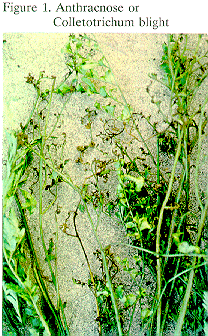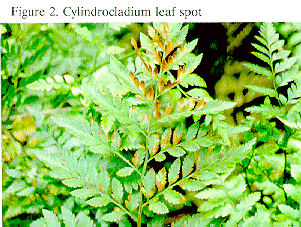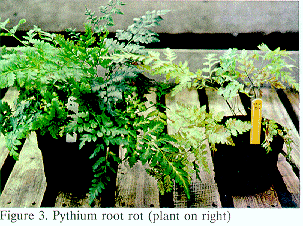Leatherleaf fern (Rumohra adiantiformis) is grown for the cut foliage markets in Europe, the United States and Canada. The majority of the fern production remains located in central Florida although offshore production has increased dramatically during the past ten years. Warm, moist weather promotes production of the fern, but also favors development of several diseases of leatherleaf fern. Despite the favorable environment, relatively few diseases are common or economically important on this crop grown in Florida.

Figure 1. Anthracnose or Colletotrichum Blight
Anthracnose has been a problem in Costa Rica for the past few years but was not reported in Florida until early this summer. The disease affects newly emerging fronds most severely by causing them to become blackened preventing development. Older fronds (mature) do not appear to be easily infected. In some nurseries the affected beds look as though a blow torch has been used on them. Fungicides which may work on this disease include Chipco 26019, Cleary's 3336, Daconil 2787, Dithane F-45, Dithane M-45, Domain, Fore, Systec and Thalonil (1). Follow labels for rates and intervals of use. Growers should be very careful not to bring in cut fern from the tropics or Florida growers with this disease.
Figure 2. Cylindrocladium Leaf Spot

Spots are pinpoint to inch long and are reddish to grayish brown. They can be water soaked and coalesce to encompass much of the frond. Disease is most severe in the summer but can occur during warm winters. The fungicides listed for anthracnose are labeled on this fern and can aid in control of Cylindrocladium leaf spot. Irrigation early in the day allows rapid drying of the foliage and can reduce disease spread.

Figure 3. Pythium Root Rot
Plants are grayish-green or chlorotic in color and may wilt. Roots are brown, mushy and reduced (stunted). Disease is rarely severe unless the fernery has poor drainage and excessive winter rains or applications of water for freeze protection are common. Aliette, Banrot, Banol, and Subdue are labeled for this disease on leatherleaf fern. Provide good drainage to avoid development of Pythium root rot.
 Figure 4.
Rhizoctonia Aerial Blight
Figure 4.
Rhizoctonia Aerial Blight
Spots occur all over the plants and are dark-brown to grayish, sometimes covering entire fronds. The web-like mycelium of the pathogen frequently spreads up the stipes onto the fronds especially in the center of the plants where the moisture levels are high. Disease is most common in the summer. The fungicides mentioned for anthracnose should aid in control of Rhizoctonia aerial blight. Keep fern cut to allow good air circulation and reduce disease development. Many other cut foliage crops are hosts of Rhizoctonia spp. and disease can readily spread from one crop to another.
Reference
- Stamps, R. H., R. A. Dunn, A. G. Hornsby, D. E. Short. and G. W. Simone. 1993. Pesticides labeled for use in commercial leatherleaf fern production in Florida - 1993. Cut Foliage Research Note, CFREC-Apopka, RH-93-B.